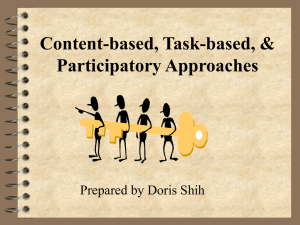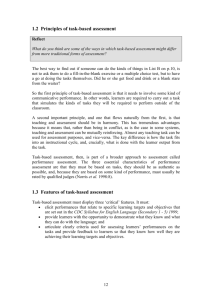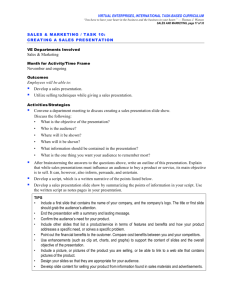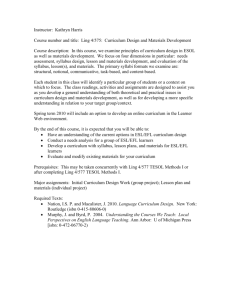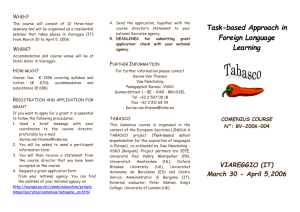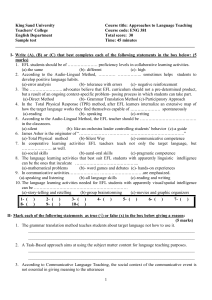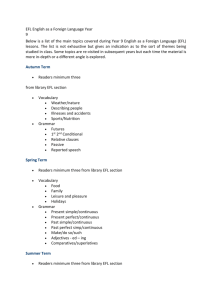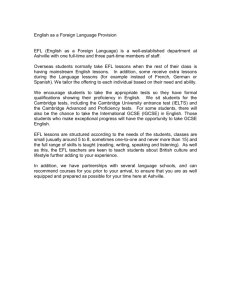Moving Beyond Traditional Reading Comprehension Activities
advertisement
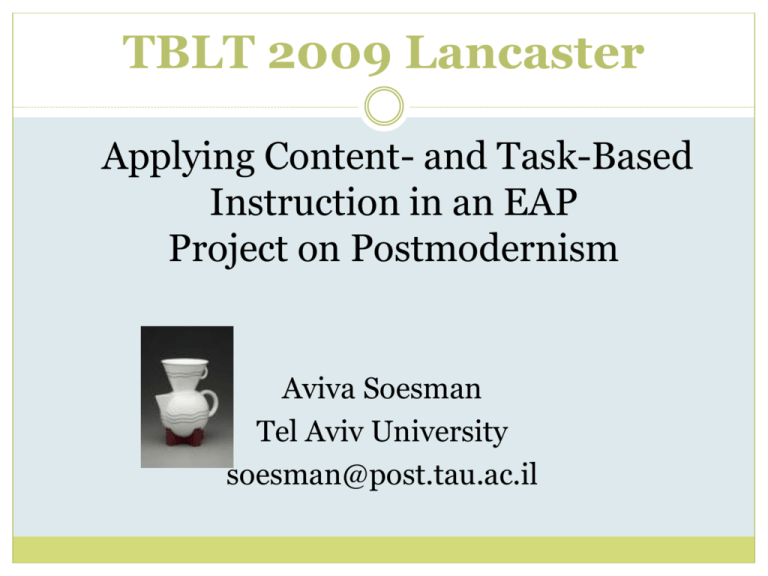
TBLT 2009 Lancaster Applying Content- and Task-Based Instruction in an EAP Project on Postmodernism Aviva Soesman Tel Aviv University soesman@post.tau.ac.il Presentation Outline Content-based Instruction – rationale / benefits Task-based Instruction – rationale / benefits The project Students’ feedback Content-based Instruction “the concurrent learning of a specific content and related language use skills” with “the selection and sequence of language elements determined by the content ” (Brinton, 2007: 11) Different models Common concept: integration/knowledge Content-based Instruction: WHY? Removes “arbitrary distinction” (Brinton, 2007: 17) Language learning more authentic - language in context and used for communicating meaning =real world (e.g., Garner & Borg, 2005; Pally, 2000) Added Knowledge (Stoller, 2002; Wesche,1993); “Two-for-one” (Wesche & Skehan, 2002: 221) Therefore: Motivation / Engagement (Nunan, 2004) Vocabulary reinforcement (Shih, 1992; Murphy & Stoller, 2001) Schemata (Pally, 2000) CBI in EAP: WHY? Bridges Gap between EFL and other courses Simulation of University settings – authentic / relevant (Stoller, 2004; Wesche & Skehan, 2002) Simulation of actual subject matter - motivating/ relevant Variety of similar subject matter = better preparation for needed skills (Shih, 1992; Kirschner & Wexler, 2002; Garner & Borg, 2005) “The most educationally appropriate approach” for EAP (Garner & Borg, 2005: 120) TBI: WHY? Communicative Activities and Meaningful language use (Jeon & Hahn, 2006; Nunan, 2004) Student-centered / autonomy (Flinch, 2005) “Learning by doing”, active (Lingley, 2006; Nunan, 2004) Collaboration (Ellis, 2003; Cobb & Lovick, 2007) Authentic – real life and academia (Nunan, 2006; Shih, 1992) TBI: WHY? Breaks Routine (Cobb & Lovick, 2007) Cognitive investment/mental effort = deeper language processing = long-term retention (Cobb & Lovick, 2007) Functional reading, read for clear purpose (Bogaert, 2005) Therefore: Student engagement and increased motivation (e.g. Cobb & Lovick, 2007; Nunan, 2004; Willis, 1996) CBI and TBI Traditional Focus on discrete language and reading comprehension skills Linguistic Knowledge CBI and TBI Focus on acquiring, synthesizing and applying knowledge Academic Literacy A Learning Sequence on PM Framework Five lessons – two core texts + other materials - Activities acquiring knowledge - Activities applying knowledge Oral presentations The Tasks Jigsaw – information gap task - groups Movie (Blade Runner) Jigsaw – pairs Pictures – reach consensus Steps, Interaction, Non-linguistic purpose, Meaning, Cognitive, Observable Outcome (Cobb and Lovick, 2007) Simulation of academic tasks Integrative Project Subtasks and oral presentation Purpose of oral presentation Three stages Instructions 1.Choose piece 2.Find source 3.Give presentation Rationale Natural sequence, but student-centered Simulation of academia: -access academic sources -synthesize information -apply theory, show understanding -analyze work of art -oral presentation Oral presentations (King, 2002; Kirschner & Wexler, 2002) Students’ Feedback Understanding of PM: 4.9 Asking questions only: 1.8 Good assessment tool: 3.8 Important skills: 3.7 Negative comments Positive comments In Conclusion Applicability in different EAP contexts References Bogaert, N. (2005, September). A task-based route to Academic Literacy. Paper presented at the International Conference on Task-Based Language Teaching. Leuven, Belgium. Brinton, D. M. (2007, June). Content-Based Instruction: Reflecting on its Applicability to the Teaching of Korean. Paper presented at the12th Annual Conference American Association of Teachers of Korean. Chicago, Illinois. Cobb, M. and Lovick, N. (2007, September). The Concept of Foreign Language Task, Misconceptions and Benefits in Implementing Task-based Instruction. Paper presented at the 2nd International Conference on Task-Based Language Teaching. Hawaii. Ellis, R. (2003). Task-based Language Learning and Teaching. Oxford: Oxford University Press. Flinch, A. E. (2005). The postmodern language teacher: The future of task-based teaching. Unpublished Document. Retrieved October 2008 from http://www.tblt.org/download/finch_handout.doc. Garner, M. & Borg, E. (2005). An ecological perspective on content-based instruction. Journal of English for Academic Purposes, 4, 119-134. Jeon, I. & Hahn, J. (2006). Exploring EFL Teachers' Perceptions of Task-Based Language Teaching: A Case Study of Korean Secondary School Classroom Practice. Asian EFL Journal, 8 (1). Retrieved October 2008 from http://www.asian-efl-journal.com/March_06_ijj.php References – Cont. King, J. (2002). Preparing EFL learners for oral presentations. The Internet TESL Journal, 8(3). Retrieved on 12 January 2003 from http://iteslj.org/Lessons/King-PublicSpeaking. Kirschner, M. & Wexler, C. (2002). Caravaggio: A design for an interdisciplinary content-based EAP/ESP unit. Journal of English for Academic Purposes, 1, 163-183. Lingley, D. 2006. A Task-based Approach to Teaching a Content-based Canadian Studies Course in an EFL Context. Asian EFL Journal, 8 (3). Retrieved October 2008 from http://asian-efl-journal.com/Sept_06_dn.php. Murphy, J.M. and Stoller, F.L. (2001). Sustained-Content Language Teaching: An emerging definition. TESOL Journal, 10 (2/3), 3-6. Nunan. D. (2004). Task-based Language Teaching. Cambridge: Cambridge University Press. Nunan, D. (2006). Task-based language teaching in the Asian context: Defining ‘task’. Asian EFL Journal,8 (3). Retrieved October 2008 from http://asian-efl-journal.com/Sept_06_dn.php. Pally, M. (2000). Sustaining interest/advancing learning: Sustained content-based instruction in ESL/EFL – Theoretical background and rationale. In M. Pally (Ed.). Sustained Content Teaching in Academic ESL/EFL: A Practical Approach (pp. 1-18). Boston: Houghton Mifflin. REFERENCES – Cont. Shih, M. (1992). Beyond comprehension exercises in the ESL academic reading Class. TESOL Quarterly, 26(2), 289318. Stoller, F. L. (2002). Content-Based Instruction: A Shell for Language Teaching or a Framework for Strategic Language and Content Learning? Retrieved 20 January 2009 from http://www.carla.umn.edu/cobaltt/modules/strategies/Stoller2002/READING1/stoller2002.htm Stoller, F. L. (2004). Content-based instruction: Perspectives on curriculum planning. Annual Review of Applied Linguistics, 24, 261-283. Wesche, M. B. (1993). Discipline-based approaches to language study: Research issues and outcomes. In M. Krueger & F. Ryan (Eds.), Language and Content: Discipline- and Content-based Approaches to Language Study (pp. 57-82). Lexington, MA: D. C. Heath. Wesche, M.B. & Skehan, P. (2002). Communicative, Task-based and Content-based language instruction. In R. B. Kaplan (ed.), The Oxford Handbook of Applied Linguistics (pp. 207-228). New York: OUP. Willis, D. (1996). A Framework for Task-Based Learning. London: Longman
